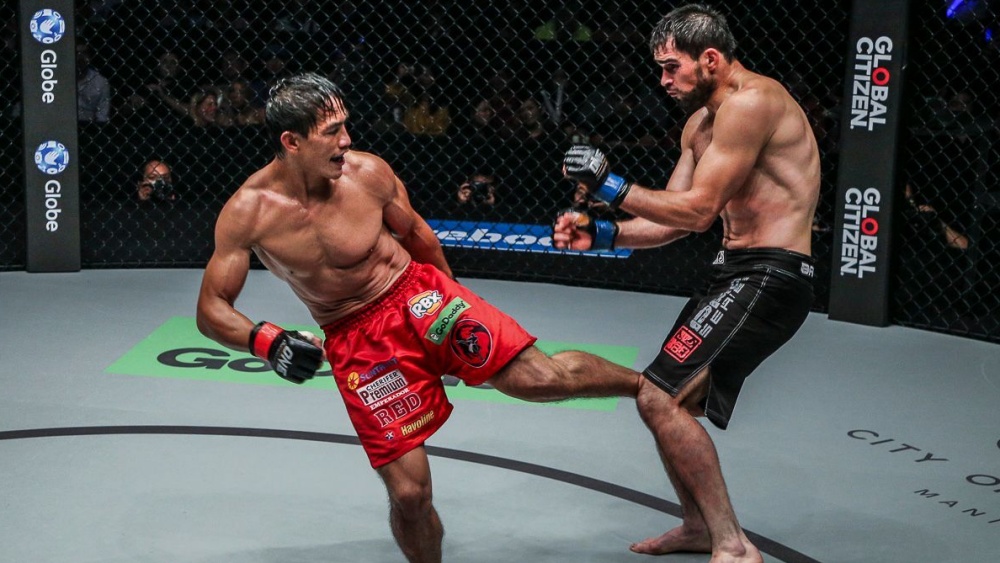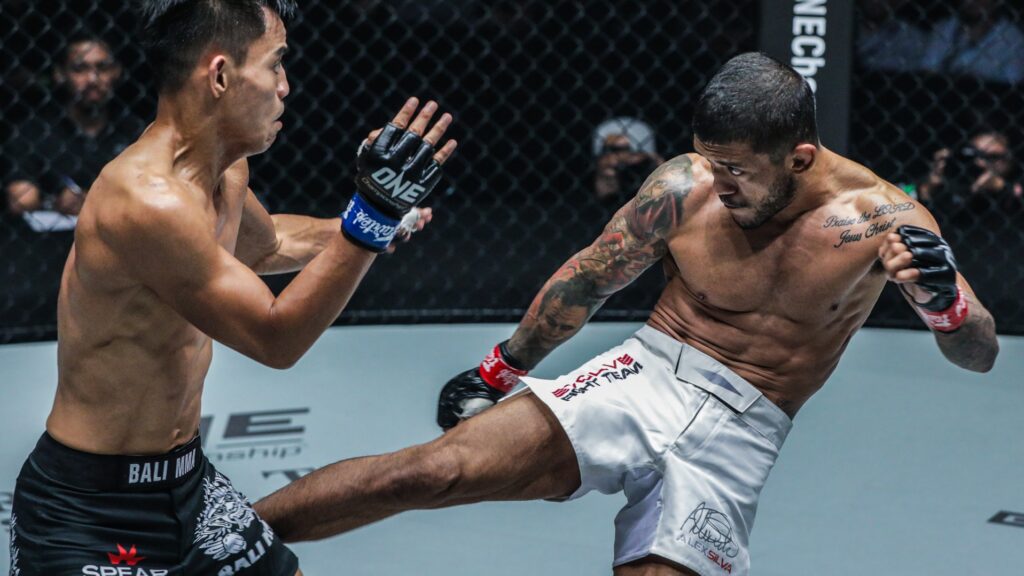
Guest post by Evolve MMA, Asia’s premier championship brand for martial arts. It has the most number of World Champions on the planet. Named as the #1 ranked martial arts organization in Asia by CNN, Yahoo! Sports, FOX Sports, Evolve MMA is the top rated MMA gym in Singapore.
Calf kicks are in vogue in MMA right now. For the past couple of years, more and more fighters have used these strikes to get their hands raised with spectacular results.
The calf kick can be a brilliant weapon for slowing your opponent down or even dealing enough damage to score a TKO.
There was once a time when some fans (and even high-ranking officials) thought leg kicks were ineffective and had no chance of finishing a fight.
This perception was shattered by some powerful strikers who excelled in targeting the thigh, but recent examples of calf kicks at the highest levels of MMA reinforced showed the heights fighters could reach when they went low.
Dustin Poirier Vs Conor McGregor
We witnessed one of the most effective uses of calf kicks in MMA at UFC 257, when “The Diamond” Dustin Poirier punished “The Notorious” Conor McGregor with those brutal calf kicks en route to a second-round TKO victory.
Jeremy Stevens Vs Gilbert Melendez
Arguably the fight that woke the MMA world up to the calf kick’s potential. Melendez is as tough as they come – a battle-hardened former World Champion – but he literally couldn’t stand up to the punishment inflicted by “Lil Heathen”.
Rafael Dos Anjos Vs Neil Magny
Evolve’s own Rafael Dos Anjos needed just one well-placed kick to take Neil Magny off his feet. That put Magny into Dos Anjos’ world, and the submission finish soon followed.
Brent Primus Vs Michael Chandler
Primus captured the Bellator title in a huge upset when his low-low kicks basically turned off Chandler’s left leg.
Rory MacDonald Vs Douglas Lima
“The Phenom’s” calf kicks were integral to his own Bellator title win in 2019, but he did even more damage with them in the first match between these two men. It’s a miracle MacDonald made it to the final bell after taking this kind of damage.
Martin Nguyen Vs Narantungalag Jadambaa
ONE Featherweight World Champion Martin Nguyen took out a legend by softening him up with his calf attack. A series of kicks caused the Mongolian to limp and made him a sitting duck for a flying knee.
What About Leg Kicks In MMA?
Though leg kicks have been popular for years, it’s only recently that we’ve seen strikers target the lower part of the leg. This could be because calf kicks are not used all that often in the stand-alone martial arts that influence the striking styles of MMA.
For example, you won’t find too many ONE Super Series kickboxing or Muay Thai athletes repeatedly go so low. If they did, there is a good chance their kicks will be checked. MMA is different because fighters are often heavy on their front legs, meaning they’re wide open to be punted.
There are also plenty of other reasons why the calf kick is perfect for use in the cage.
? Low-energy – It does not take much effort to throw, so it can be used at any time or as part of any game plan.
? Simplicity – You don’t need much flexibility or technical excellence. These strikes are as simple as kicking gets. You don’t need to be very strong, powerful, or explosive to deal damage, either.
? Speed – Calf kicks are harder to see coming, which makes them hard to defend and counter.
? Surprise factor – Most fighters train to defend kicks to the thigh, so they could be caught out.
? Wrestler-proof – Because the strike is so low, it’s harder for a grappler to catch your leg and put you on the mat.
? Efficiency – Just a few well-placed calf kicks can seriously damage your opponent’s lead leg. It might take many more blows to the thigh for a similar effect on the fight.
? Effectiveness – Damage to the leg will slow a fighter down and compromise their ability to strike or shoot for takedowns. In turn, that will leave them more open to other aspects of your offense, or, if you continue to target the calf, a finish.
? Diversity – Any enhancements you can make to your skillset will make you a more dangerous and effective overall martial artist. The greater the variety of strikes you can throw at your opponents, and the more areas of the body you can target, the better.
How Does It Work?

The calf kick is such a potent weapon because of how vulnerable that area of the leg is.
A ‘regular’ leg kick sees the attacker’s shin dig into the meat of their opponent’s thigh. That will hurt most people, but pro athletes’ upper legs are strong, muscular, and conditioned to absorb that kind of punishment. Only the very best leg-kickers out there are likely to cause a lot of damage.
In contrast, the muscles on the lower part of the leg are smaller and offer little protection to the nerves. They include your sciatic nerve – the largest nerve in the human body, which runs all the way down your leg from your spine to your foot. If it is hit hard, you will feel it.
That is great news for the attacker. The lower portion of the leg has little to no muscle to protect the sciatic nerve. A direct hit to the side of the calf or the area just below the calf could cause a limp immediately. A few more strikes could temporarily shut down the limb completely.
What’s more, well-placed blows can also damage the fibula – the long, thin bone behind your tibia (shin bone). That is what stabilizes the ankle and supports the muscles of the lower leg, so if that gets cracked, it’s game over.
Reasons Not To Throw The Calf Kick

For all the benefits of the calf kick, there are a few risks, too. In fact, some coaches are so wary about some of these potential dangers that they will not even teach calf kick to their students.
? Clashing shins – One of the ways to defend the calf kick is with a hard check. Hat means shin-on-shin impact, which is going to hurt both athletes.
? Foot damage – If you’re too far away from your target and land with your foot rather than the hard part of your shin, there’s a chance you could damage the small, fragile bones in your foot.
? Tibia damage – the lower part of your shin is much weaker than the upper and middle parts, so it is also vulnerable if you get your distance wrong and strike with it.
? Boxing reprisals – If you get your range right when you kick, you might just be in danger of eating some hard punches.
With all of that said, there’s a risk involved with pretty much every technique from any branch of martial arts.
Many of these are just as likely if you’re aiming further up the leg, and any Muay Thai veteran will tell you that you have to get used to clashing shins wherever you aim your kicks (except maybe to the head).
How To Throw An Effective Calf Kick
For a masterclass in calf kick execution, Evolve Fight Team Head Coach Siyar Bahadurzada have you covered in our guide to calf kicks for MMA. If you need a refresher, remember these principles.
? Strike with full power – a weak leg kick opens you up to a lot of risk for very little reward. If you clash shins with your rival without fully committing, you’ll come off much worse.
? Attack at close range – The further away you are, the more likely you are to land with the weakest parts of your leg and cause more harm to yourself.
? Keep your hips back – this will help you generate power and minimize the negative results from getting checked.
? Step outside – Cutting an angle on your opponent will take you away from their counters and put you in a position to land on the most vulnerable part of their leg.
? Catch them by surprise – If you look at your rival’s leg, they’ll know you’re going to attack it. Keep a poker face by looking straight ahead or even looking high to catch them out.
? Condition your shins – Stronger shins mean stronger kicks. Evolve has you covered with a complete guide to gaining iron bones.
How To Defend The Calf Kick
With practice, you should be a pro when it comes to the calf kick, but what if your leg is the target of the technique?
Luckily there are plenty of ways to counter opponents who target the lower portion of your leg. With more practice, you can establish a huge arsenal of techniques to frustrate your rivals and make them pay.
? Checks – The age-old kick defense. Turn your shin outward and force shin-on-shin impact. This is a technique that is going to hurt you, too, but it will hurt your foe just as much, if not more, and probably put them off trying this technique again.
? Get out of range – Another obvious antidote. If you don’t want to get hit with a calf kick, step back to make sure it won’t land.
? Counter cross – If your opponent does not get off the centerline, they’ll be an easy target to get hit with a lead straight punch. You may have to absorb some damage, but a hard punch to the jaw in return could give you an instant KO as a reward.
? Switch stances – If your leg has been torn up by kicks, move it back to protect it. There are drawbacks to this approach, though.
? If you’re not comfortable in the opposite stance, you’ll struggle to be effective.
? This is a tell-tale sign that you’re hurt. If you return to your original stance, you can bet your opposite number will target your front leg again.
? Shift your weight – Put more weight on your back leg to make defense easier. However, this will make you more vulnerable to takedowns.
The best way to master all of these offensive and defensive techniques is to practice, practice, practice with your training partners. The more drills you do, and the more you can throw calf kicks in sparring, the better you’ll get.
The final thing to remember is that you must wear shin guards for these kinds of drills, or you’ll end up limping home after class!